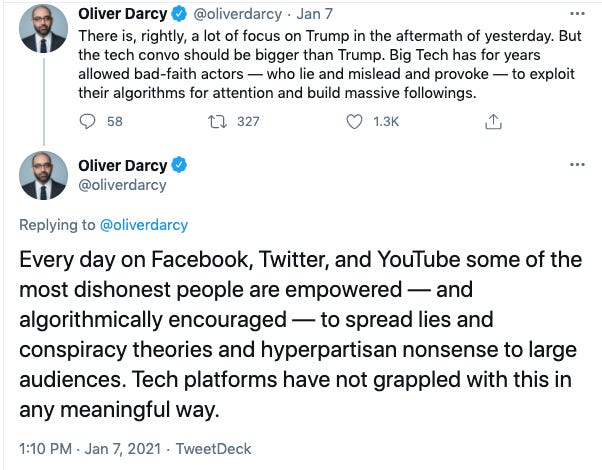 |
| New York Times reporter Taylor Lorenz and Silicon Valley investor Marc Andreessen |
The NYT's Taylor Lorenz falsely accuses a tech investor of using a slur after spending months trying to infiltrate and monitor a new app that allows free conversation.
A new and rapidly growing journalistic “beat” has arisen over the last several years that can best be described as an unholy mix of junior high hall-monitor tattling and Stasi-like citizen surveillance. It is half adolescent and half malevolent. Its primary objectives are control, censorship, and the destruction of reputations for fun and power. Though its epicenter is the largest corporate media outlets, it is the very antithesis of journalism.
I’ve written before about one particularly toxic strain of this authoritarian “reporting.” Teams of journalists at three of the most influential corporate media outlets — CNN’s “media reporters” (Brian Stelter and Oliver Darcy), NBC’s “disinformation space unit” (Ben Collins and Brandy Zadrozny), and the tech reporters of The New York Times (Mike Isaac, Kevin Roose, Sheera Frenkel) — devote the bulk of their “journalism” to searching for online spaces where they believe speech and conduct rules are being violated, flagging them, and then pleading that punitive action be taken (banning, censorship, content regulation, after-school detention). These hall-monitor reporters are a major factor explaining why tech monopolies, which (for reasons of self-interest and ideology) never wanted the responsibility to censor, now do so with abandon and seemingly arbitrary blunt force: they are shamed by the world’s loudest media companies when they do not.
Just as the NSA is obsessed with ensuring there be no place on earth where humans can communicate free of their spying eyes and ears, these journalistic hall monitors cannot abide the idea that there can be any place on the internet where people are free to speak in ways they do not approve. Like some creepy informant for a state security apparatus, they spend their days trolling the depths of chat rooms and 4Chan bulletin boards and sub-Reddit threads and private communications apps to find anyone — influential or obscure — who is saying something they believe should be forbidden, and then use the corporate megaphones they did not build and could not have built but have been handed in order to silence and destroy anyone who dissents from the orthodoxies of their corporate managers or challenges their information hegemony.
Oliver Darcy has built his CNN career by sitting around with Brian Stelter petulantly pointing to people breaking the rules on social media and demanding tech executives make the rule-breakers disappear. The little crew of tattletale millennials assembled by NBC — who refer to their twerpy work with the self-glorifying title of “working in the disinformation space”: as intrepid and hazardous as exposing corruption by repressive regimes or reporting from war zones — spend their dreary days scrolling through 4Chan boards to expose the offensive memes and bad words used by transgressive adolescents; they then pat themselves on the back for confronting dangerous power centers, even when it is nothing more trivial and bullying than doxxing the identities of powerless, obscure citizens.

But the worst of this triumvirate is the NYT’s tech reporters, due to influence and reach if no other reason. When Silicon Valley monopolies, publicly pressured by Rep. Alexandria Ocasio-Cortez (D-NY) and other lawmakers, united to remove Parler from the internet, the Times’ tech team quickly donned their hall-monitor goggles and Stasi notebooks to warn that the Bad People had migrated to Signal and Telegram. This week they asked: “Are Private Messaging Apps the Next Misinformation Hot Spot?” One reporter “confess[ed] that I am worried about Telegram. Other than private messaging, people love to use Telegram for group chats — up to 200,000 people can meet inside a Telegram chat room. That seems problematic.”
These examples of journalism being abused to demand censorship of spaces they cannot control are too numerous to comprehensively chronicle. And they are not confined to those three outlets. That far more robust censorship is urgently needed is now a virtual consensus in mainstream corporate journalism: it’s an animating cause for them.
"Those of us in journalism have to come to terms with the fact that free speech, a principle that we hold sacred, is being weaponized against the principles of journalism," complained Ultimate Establishment Journalism Maven Steve Coll, the Dean of Columbia University’s Graduate School of Journalism and a Staff Writer at The New Yorker. A New Yorker and Vox contributor who runs a major journalistic listserv appropriately called “Study Hall,” Kyle Chayka, has already begun shaming Substack for hosting writers he regards as unacceptable (Jesse Singal, Andrew Sullivan, Bari Weiss). A recent Guardian article warned that podcasts was one remaining area still insufficiently policed. ProPublica on Sunday did the same about Apple, and last month one of its reporters appeared on MSNBC to demand that Apple censor its podcast content as aggressively as Google’s YouTube now censors its video content.
Thus do we have the unimaginably warped dynamic in which U.S. journalists are not the defenders of free speech values but the primary crusaders to destroy them. They do it in part for power: to ensure nobody but they can control the flow of information. They do it partly for ideology and out of hubris: the belief that their worldview is so indisputably right that all dissent is...
Read More HERE
No comments:
Post a Comment